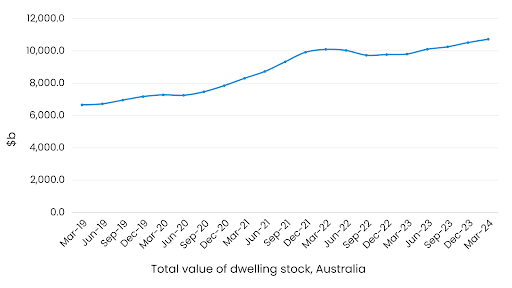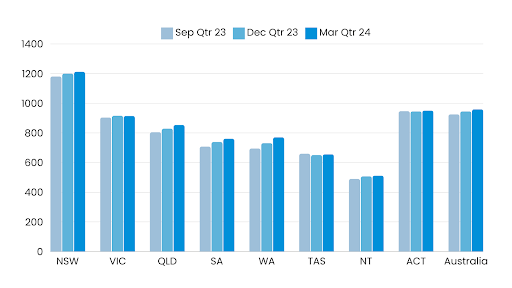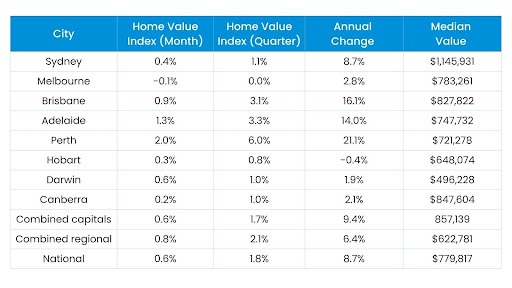In 2023, Australia’s property market achieved a historic milestone by surpassing the $10 trillion mark for the first time. This landmark achievement highlights the market’s sustained growth and resilience despite various economic challenges.
Historically, the Australian property market has shown robust performance with significant value appreciation. For example, it surpassed $5 trillion in 2013 during a housing boom driven by favourable economic conditions and $7 trillion in 2017 due to low interest rates and strong demand. Reaching $10 trillion by 2023, particularly in the wake of global disruptions like the COVID-19 pandemic, underscores this remarkable growth.
By May 2024, the market’s value continued to rise, reaching $10.7 trillion. This post explores the market trends leading to this milestone, provides a historical overview from 2022 to 2024, and offers insights into recent and city-specific trends.
At Unconditional Finance, we prioritise providing tailored financial solutions and expert guidance to help you navigate the complexities of the property market. Our dedicated team of professionals is committed to ensuring your financial success by offering personalised advice and support at every step of your property journey. Whether you’re a first-time homebuyer, a seasoned investor, or looking to refinance, we are here to help you achieve your property goals with confidence.
Property Market Value Trend
From 2022 to 2024, the Australian property market has seen considerable fluctuations. In March 2022, the total value of residential dwellings was $10.17 trillion, rising steadily to $10.72 trillion by March 2024. The mean dwelling price also saw an increase from $941,900 in March 2022 to $959,300 in March 2024.
Several factors contributed to these value changes. Economic policies, such as the Reserve Bank of Australia’s adjustments to interest rates, played a crucial role. Lower interest rates during this period made borrowing more accessible, thereby increasing demand for residential properties. Additionally, government incentives for first-time homebuyers and investors further stimulated market activity.
Global events also had significant impacts. The COVID-19 pandemic initially caused uncertainty, but subsequent fiscal stimulus packages and changes in consumer behaviour, such as the increased demand for spacious homes suitable for remote work, drove market growth. Furthermore, the return of international buyers and immigrants as travel restrictions eased contributed to the rising property values.

Source: Total Value of Dwelling Stock, Australian Bureau of Statistics, 2024

Source: Mean Dwelling Price, Australian Bureau of Statistics, 2024
These visual presentations show a clear upward trend in both the total value of dwelling stock and the mean dwelling price, reflecting the overall growth in the property market.
City-Specific Trends
Different cities in Australia have experienced varied trends in the property market. Below is a table summarising key metrics for major cities:

Source: Home Value Index, CoreLogic, 2024
- Sydney: Sydney’s high median property value is largely due to powerful demand from both domestic and international buyers. The city’s constrained land availability and strict zoning laws also drive property prices up.
- Melbourne: While experiencing steady growth, Melbourne faces challenges such as an oversupply of apartments in certain areas. Economic recovery post-pandemic and population growth are expected to drive future demand.
- Brisbane: Known for its relatively affordable housing, Brisbane has seen significant interest from interstate migrants. Economic development projects and improved infrastructure are key drivers of its property market.
- Adelaide: Adelaide’s market benefits from a stable economy and affordable living costs.
- Perth: The resource sector’s performance heavily influences Perth’s property market. Recent increases in commodity prices have positively impacted housing demand.
- Canberra: As the political centre, Canberra experiences consistent demand for housing, driven by a stable job market and government employment.
- Darwin: Darwin’s market remains smaller and more volatile, with significant influence from the defence sector and seasonal employment trends.
- Hobart: Hobart has seen a surge in property values due to its lifestyle appeal and relatively low prices compared to mainland cities.
National Trends
Despite obstacles like high interest rates and inflation, the property market is experiencing nationwide growth. The consistent increase in the total value of dwellings and mean dwelling prices reflects a robust market that adapts to economic conditions.
Broader national economic indicators such as GDP growth, employment rates, and consumer confidence have shown resilience, contributing positively to the property market.
Economic Indicators Correlation
- Interest Rates: Despite recent hikes in interest rates by the Reserve Bank of Australia, the property market has continued to show growth. Historically, low interest rates during the pandemic spurred buying activity, which has carried forward despite the subsequent rate increases aimed at controlling inflation.
- Inflation: Inflation impacts the property market by influencing both buyer behaviour and construction costs. Higher inflation rates typically lead to increased costs for building materials and labour, pushing property prices up. However, a strong job market and wage growth have helped mitigate some of these inflationary pressures on buyers.
- Employment: High employment rates contribute to economic stability and consumer confidence, encouraging property investments. Regions with higher employment growth tend to see stronger property market performance.
Future Outlook
The outlook for Australia’s property market in 2024 is optimistic. Industry experts predict that continued demand, coupled with limited supply, will drive further growth.
Expert Predictions:
- CoreLogic forecasts moderate growth in the property market, supported by low unemployment rates and strong consumer confidence. Despite the challenges of high interest rates and inflation, the property market is expected to show resilience. CoreLogic’s Head of Residential Research, Eliza Owen, mentioned that while growth might slow compared to the previous year, housing values are still projected to rise, driven by ongoing demand and limited supply.
- REIA (Real Estate Institute of Australia) highlights that government infrastructure projects and urban development plans will positively impact property values. These projects, including new transport links and community amenities, are expected to enhance the desirability of certain areas, further boosting property prices.
Government Policies:
Potential government policies, such as increased support for first-home buyers, development of affordable housing projects, and incentives for sustainable building practices, are expected to sustain market growth. Policies aimed at increasing housing supply could alleviate some price pressures, making homeownership more accessible. The federal government has set a target of 1.2 million homes, supported by significant funding for social and community housing, infrastructure spending, and focused support for new housing developments.
Economic Influences
Interest rates, inflation, and government policies play a crucial role in shaping the property market. The Reserve Bank of Australia’s decisions on interest rates are crucial in shaping market trends.
- Interest Rate Changes: Historically, low interest rates during the pandemic spurred buying activity, with many first-time buyers entering the market. Recent increases aim to control inflation but have also led to higher mortgage costs, which may temper demand.
- Inflation: Inflation impacts both construction costs and consumer purchasing power. Rising costs for materials and labour can lead to higher property prices, but wage growth helps offset these costs for buyers.
- Government Policies: Policies aimed at stimulating economic growth, such as tax incentives for property investments and grants for first-home buyers, play a critical role in market dynamics.
Market Challenges
Challenges such as affordability, housing supply, and regulatory changes remain. Addressing these issues will be vital for sustaining market growth.
Affordability: High property prices, particularly in major cities, make affordability a significant concern. Strategies such as increasing the availability of affordable housing and offering grants to first-time buyers can help.
Housing Supply: Limited housing supply in high-demand areas leads to price increases. Encouraging new developments and easing zoning regulations can boost supply.
Regulatory Changes: Changes in regulations can have a significant impact on the market. Stable and predictable regulations help to sustain investor confidence and market stability.
Proposed Solutions:
- Increasing Supply: Developing new housing projects and incentivising the construction of affordable homes.
- Supporting First-Time Buyers: Offering financial assistance and tax incentives.
- Sustainable Development: Encouraging eco-friendly building practices to meet the growing demand for sustainable living.
Conclusion
Australia’s property market demonstrates remarkable resilience and consistent growth, surpassing the $10 trillion mark in 2023 and reaching $10.7 trillion by May 2024. This achievement underscores the market’s robust nature despite global economic disruptions and challenges such as high interest rates and inflation.
Key milestones have been driven by favourable economic conditions, supportive government policies, and global events. Looking ahead, the market’s future remains optimistic, with strong demand, limited supply, and strategic government initiatives playing vital roles. City-specific trends reflect unique local dynamics influenced by economic opportunities, infrastructure investments, and lifestyle appeal.
Industry experts forecast moderate growth, supported by solid economic indicators and government measures aimed at increasing housing supply and affordability. These factors are expected to further bolster the market, ensuring continued growth and stability.
If you’re looking to buy, sell, or invest in Australia’s dynamic property market, now is the time to act. For personalised advice tailored to your needs, reach out to our mortgage brokers in Sydney today. Gain insights into the latest market trends, make informed decisions, and confidently navigate the property market with our professional guidance. Reach out to us today to get expert advice and take the next step in your property journey.
FAQs
- What factors contributed to the recent milestone in Australia’s property market? The recent milestone was achieved through a combination of favourable economic conditions, supportive government policies, low interest rates, and increased demand from both domestic and international buyers.
- How has the COVID-19 pandemic impacted the property market in Australia? The COVID-19 pandemic initially caused uncertainty, but subsequent fiscal stimulus packages, changes in consumer behaviour, and the return of international buyers and immigrants have driven market growth.
- What are the current trends in different cities across Australia? Cities like Sydney and Melbourne continue to see high demand and property values due to economic opportunities and infrastructure investments. Brisbane, Perth, and Hobart are experiencing growth driven by affordability and lifestyle appeal.
- What is the future outlook for Australia’s property market? The future outlook remains optimistic, with industry experts predicting continued growth supported by strong economic indicators, government infrastructure projects, and ongoing demand.
- How do interest rates and inflation affect the property market? Interest rates and inflation significantly impact the property market. Low interest rates have historically spurred buying activity, while high inflation rates can increase construction costs and push property prices up. However, a strong job market and wage growth help mitigate these effects.
- What government policies are expected to support the property market? Government policies aimed at increasing housing supply, supporting first-home buyers, and promoting sustainable building practices are expected to sustain market growth and make homeownership more accessible.
- How can I stay updated with the latest property market trends? Subscribe to our newsletter, follow reputable market research reports from sources like CoreLogic and the Australian Bureau of Statistics, and seek advice from industry experts.
- What are the key takeaways for property investors? Property investors should focus on regions with strong economic growth, infrastructure investments, and high demand. Emerging trends in sustainability and technology also offer new opportunities for returns.
- How can I get personalised advice for my property needs? For insights tailored to your unique needs, consider consulting with a financial advisor or real estate expert who can provide personalised guidance and recommendations.